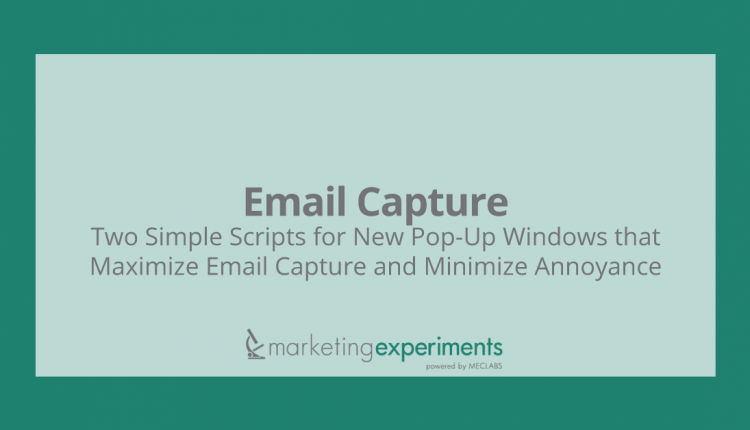Email Capture
Two Simple Scripts for New Pop-Up Windows that Maximize Email Capture and Minimize Annoyance
You can listen to a recording of a clinic on this subject here:
Is there a way to acquire the benefits of an email-capture pop-up window, without incurring its (potentially serious) liabilities? Is there a way to use a pop-up window on your website without Google rejecting your AdWords campaign?
The humorist Nora Ephron (1941) once said, ” I am continually fascinated at the difficulty intelligent people have in distinguishing what is controversial from what is merely offensive.” (*1)
Web marketers have the same problems when it comes to pop-up windows. But the issue is a critical one, as an email-capture pop-up can double the growth of your list.
In a previously reported experiment, we conducted a six-week test on the impact of an email-capture pop-up window. It is important to review those results, as they may help to underscore the value of the two enclosed scripts.
| New Subscribers Captured without the Use of a Pop-Up Window |
|
|---|---|
| PERIOD | NEW SUBSCRIBERS |
| WEEK 1 | 37 |
| WEEK 2 | 42 |
| WEEK 3 | 44 |
| TOTAL | 123 |
| New Subscribers Captured WITH the Use of a Pop-Up Window |
|
|---|---|
| PERIOD | NEW SUBSCRIBERS |
| WEEK 1 | 71 |
| WEEK 2 | 84 |
| WEEK 3 | 77 |
| TOTAL | 232 |
What You Need To UNDERSTAND: The use of the pop-up window generated 190% of the subscribers of the original effort.
Email-capture pop-up windows are GOOD for these reasons:
- They can capture many more email addresses than a standard web page form.
- Leveraged properly, these email addresses can dramatically reduce your customer acquisition costs and increase your yield per visit.
Email-capture pop-ups can be BAD for these reasons:
- Many customers find pop-ups obnoxious. Used improperly, pop-ups can anger your site visitors (and even reduce your sales).
- Google AdWords Select does not allow a pop-up window on your landing page.
KEY POINT: The best publishers are good retailers; the best retailers are good publishers.
But most publishers and retailers are frustrated in their efforts to capture more email addresses. Pop-ups have been the most effective way to get the attention of site visitors, but many marketers are afraid to use them.
So how can we gain the benefits without incurring the liabilities?
The Research Team at MEC has been testing and developing two solutions. The first is unique. The second is “talked about” on the Net, but hardly ever executed correctly.
Solution 1
The first solution feels like a pop-up, it works like a pop-up, but it is actually a JavaScript rollover. Here are the key points:
- The rollover is anchored either to graphics or to text on your site.
- When a visitor’s mouse (inadvertently) passes over the anchor, a small box materializes.
- You can see a sample here by sliding your mouse over the “What is MarketingExperiments.com?” graphic:www.marketingexperiments.com
- KEY POINT: Because it is not a true pop-up window, this does not violate the rules of Google AdWords and can be used on your primary landing pages.
In the NOTES section of this report, we have included a link to the code for executing SOLUTION 1.
Solution 2
The second solution is a pop-up, but it is different in a fundamental way:
- It pops up only once for a single IP address. This reduces the “annoyance” factor.
- It pops up on exit. This is very important as it allows you to sequence the order of offers a visitor receives.
In the NOTES section of this report, we have included a link to the code that we use on our own site for executing SOLUTION 2.
We will release a Research Brief on message sequencing in the near future. In the meantime, just remember that a visitor’s “eye path” and “decision-making sequence” are critical factors in the overall success of your site.
KEY POINT: Too often, site visitors are presented with the wrong offers, in the wrong order. This can undermine your objective.
You can use this pop-up as your final attempt to capture the email address of a visitor who does not otherwise engage with your offers.
Everyone has heard of exit pop-ups, but trying to find a good script that combines them with a “pop up once in X days” element is hard to find.
In the NOTES section of this report, we have included a link to the code that we use on our own site for executing SOLUTION 2.
Related MEC Reports:
Recorded Clinic:
(*1) Nora Ephron (b. 1941), U.S. author and humorist. Scribble Scrabble, ch. 10 (1978).
Credits:
Editor — Flint McGlaughlin
Contributors — Brian Alt
Cliff Rainer
HTML Designer — Cliff Rainer



